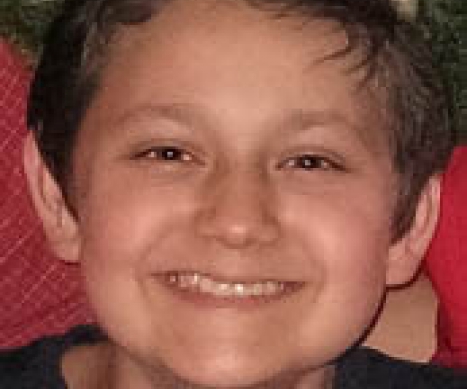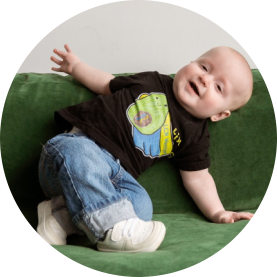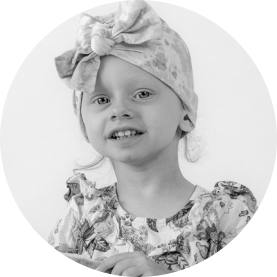- Leukemia


Click the images to see them larger above!
Learn more about
Leukemia
Get the facts about Leukemia and how our research projects are making a difference.
Learn More »To tell the story of my 12-year-old son Thomas’s battle with leukemia, I guess I would have to begin when he was barely 3-years-old in 1999.
That summer, I noticed he was getting more and more bruises on his legs. However, this was also around the time that he was getting into superheroes and Power Rangers, and I knew he played “rough” with the other boys on the playground. Also that summer, the temperatures were over 100 degrees every day – it was one of the hottest summers on record here - so when he didn’t want to play outside and preferred to stay inside for quiet play I wasn’t worried.
He had also been prone to ear infections, and when I took him to the pediatrician for a follow-up visit for his latest infection, I showed the doctor that one of the lymph nodes in his groin area was enlarged. The doctor also noticed the bruises on his legs. He then felt under Thomas’s arm and felt another enlarged lymph node. He said that it must be some type of blood infection and sent us to a lab to have blood work done. I assumed that it was just an infection and that Thomas would just need antibiotics and that was it.
The next day I received a call on my way to work from the doctor that Thomas was extremely ill, and that he needed to go to see the hematologist right away. I pressed the doctor to tell me what it was – I could tell it was very bad by his tone. He reluctantly told me it was leukemia. That was the moment my life changed forever and my family’s journey with leukemia began.
It turned out the hematologist was also an oncologist, and when Thomas and I met my husband at the clinic, we learned that Thomas had cancer cells in his blood. We were going to be admitted to Children’s Hospital right then and there and would probably be there for up to two weeks. Also, we would be starting chemotherapy the following morning after Thomas received two units of platelets, two units of red cells, and surgery to place a central line in his chest. I remember the shock I felt when the doctor then told me that he would be getting chemotherapy treatments for three years and two months. I also remember the shock I felt when I asked the doctor, “When will he be considered cured?” And the doctor replied, “When he’s been off treatment for 5 years with no recurrence.” I quickly did the math and asked, “So when he’s 11 years old?” It seemed like an eternity at the time.
We were very lucky, in that Thomas achieved remission within 3 weeks, so we knew that the chemotherapy was working. It was so very difficult to try to explain to a 3-year-old that the medicine that was making him feel so weak and sick was actually helping him to “get better.” Most adults have a difficult time understanding the complexities of cancer and its treatment – try explaining it to a 3- year-old. We told him the cancer cells were the bad guys and the chemo meds were the good guys and that they were going to have a battle, and that he was going to feel bad from it, but hopefully, it meant that the good guys were beating the bad guys.
In October ’99, we met Lance Armstrong at Children’s Hospital for the Wheaties press conference after Lance had won his fist Tour De France. Although Thomas doesn’t remember it, we were very inspired and given much hope based on Lance’s story.
During the most intense phases of treatment, Thomas was admitted to the hospital several times for very high fevers caused by one of the chemotherapy meds. At his worst, he was unable to walk or even talk due to dehydration and fatigue. At the age of 4, he weighed 27 pounds.
Shortly after he began the two year maintenance phase, we learned that his fine motor skills had been weakened, and we enrolled him in special education pre-school classes and began focusing on all the long-term “survivorship” issues and effects the chemotherapy was having on him physically, neurologically, and emotionally.
In September 2002, he had his last dose of chemotherapy and took those final chemotherapy pills at home. He started 1st grade and over the next few years, our lives became “normal” again, although he still struggled with some of the effects of the chemotherapy.
He began going to martial arts classes in 2003, and in October 2006 he won the gold medal for his age group at the international tournament. He had worked so hard, and it was such a proud moment for all of us. It was his “Tour de France” I guess.
He also began guitar lessons and had, by this time, become an avid reader and fan of fantasy fiction – Harry Potter, Lord of the Rings, and Japanese Manga. All stories about unlikely heroes battling monsters, both literally and figuratively, and having to confront and conquer their own fears and insecurities – just as Thomas had done.
In August of 2007, Thomas had the privilege of being one of the first patients of the LiveStrong Childhood Cancer Survivorship Clinic. Since he had been off-treatment for 5 years, he was officially pronounced “cured,” and we were given a book on survivorship issues and told what medical tests he should have done periodically the rest of his life to check for any ill effects from the chemotherapy on his heart, liver, brain, or bones.
Amazingly, he got to meet Lance Armstrong once again for the grand opening of the survivorship center in September ‘07. I thought how fitting it was that he had met Lance back at the very beginning of his battle, and was now getting to meet him again as an official “survivor” 8 years later.
Just 3 months after, in November, Thomas was going to bed and I noticed bruises on his legs when he came into his room telling me his nose was bleeding. He had been very fatigued recently and I thought it was because he had just started middle school and the stress of all the changes was wearing him out. But when I saw those too-familiar bruises combined with the nose bleed, I knew it was time to call the doctor. I dreamt all night that he had developed AML, a different form of leukemia that he is at risk of developing from all the chemo meds he had earlier in his life. It never occurred to me that this could be a relapse of the original leukemia.
The blood tests were not normal, but there were no signs of cancer cells in the blood, so his oncologist decided to do a bone marrow aspiration to see if any cancer cells were starting to grow there. To our horror, the test showed that 86% of his bone marrow were cancer cells, and that these were the same cells from 8 years before. The cancer had been lying dormant all these years, unbeknownst to any of us.
We met with a bone marrow transplant team in San Antonio and they told us that relapses this late happen maybe once or twice a year. My husband asked, “You mean in San Antonio?” They replied, “No, we mean in the U.S.”
It was quite surreal starting Thomas back on chemotherapy with the same doctor and some of the same nurses from 8 years before. Even though he was the same person, he was now an 11-year-old boy, who knew what cancer was and knew the very real implications of this relapse. This time, he understood about why the chemotherapy was making him feel so sick, but this time, he also knew he could die. Those first few months, he asked us many times, “Am I going to die?” and he would tell us, “I don’t want to die.”
Thomas immediately began intensive relapse chemotherapy and again, got to remission fairly quickly, which meant he didn’t require a bone marrow transplant. By the third month of chemo, his immune system was completely wiped out (literally at zero) and he developed a blood infection and went into septic shock and was in the hospital for almost two weeks.
He endured 4 more months of heavy chemotherapy after that and began maintenance chemotherapy in July ’08. He is scheduled to complete treatment in March of 2011, the month of his 15th birthday. By that time, he will have had close to 7 years of chemotherapy in his 15 years of life.
He is now back at school part-time (after missing most of the 6th grade) and doing well. His hair has grown back, he occasionally goes to martial arts class and he still reads about heroes of all times and places.
Thomas is truly a hero in every sense of the word. He has faced the possibility of death and experienced immense suffering on so many levels in his 12 years. What mythological monsters could be worse than that?
He maintains a positive outlook on life, and at the young age of 12, is committed to advocating and raising money for childhood cancer research. We have certainly learned more about life from him than he will ever learn from us, and we know that the best is yet to come!
I am so honored to call myself his mom, and look forward to seeing how the world will be a better place for having him in it. It already is.
Update: Thomas relapsed in his central nervous system in August 2009 and will receive stem cell transplant in December 2009.
Written by Lisa Molina, Mother of Thomas, cancer warrior.
Posted 02/09
Donate in Honor of Thomas Today!
Your donation helps to fund critically-needed research to find better treatments and cures for children with cancer.





